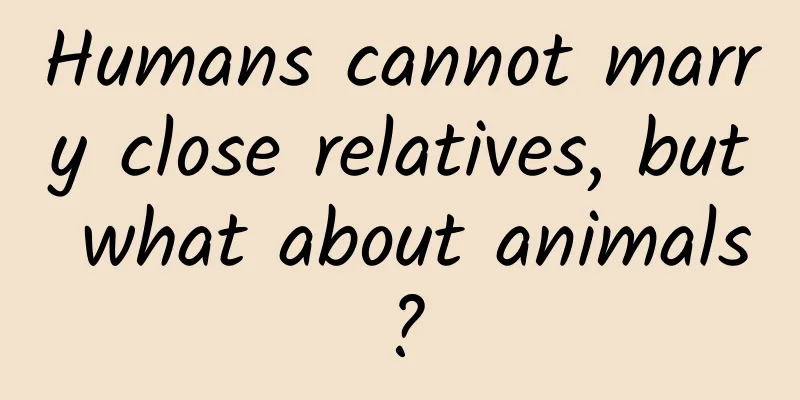Humans cannot marry close relatives, but what about animals?

|
I recently saw an interesting content: "Why can't humans marry close relatives, while other animals have no problem with close relatives?" Is this really the case? This is another typical "ask if first, then ask why" question. Most countries do not encourage or even prohibit marriage between close relatives. Article 6 of China's Marriage Law stipulates: "Marriage between direct blood relatives and collateral blood relatives within three generations is prohibited." So why is it not recommended for humans to marry close relatives? Is it really okay for animals to marry close relatives? Today, let's talk about the issue of inbreeding in detail. 01. Why do humans not recommend marriage between close relatives? As we all know, inbreeding is mainly promoted because of the potential genetic diseases that may occur as a result of gene homozygosity. Does homozygosity necessarily mean that genetic diseases are exacerbated? In fact, many people have been indoctrinated with this idea. However, they do not realize that, in fact, what if the person does not have the gene for genetic diseases? In fact, the probability of genetic diseases occurring is very low. In addition, what if this family has excellent genes? Homozygosity will lead to the concentration of excellent genes, thus becoming more excellent. Because we know that inbreeding will make genes more pure (the proportion of homozygosity increases), and the increase in homozygosity will have two consequences. a: Advantages gather and magnify (such as IQ, physique) b: Disadvantages are aggregated and amplified (mainly genetic diseases) As a manager, A is acceptable, but B is more troublesome. After all, for a patient with a genetic disease, not only the patient himself, but also the entire family or even more people may need to make more investment. After weighing the pros and cons, in order to avoid B, close relatives are prohibited from marrying. 02. Who says there is nothing wrong with close relatives of animals? For most people, the most intuitive issue of animal inbreeding is breed selection, which is typical in the pet industry. The result of the crazy pursuit of "bloodline" and "purebred" is a large number of genetic diseases. The following passage is from Introduction to Animal Welfare: Other authoritative organizations, such as the Universities Federation for Animal Welfare (UFAW) website, list a variety of common genetic diseases in dogs and cats. Recent studies in the UK have also shown that all 50 of the most popular breeds registered with the UK Kennel Club have genetic diseases. For example, the following diseases: v 1. Eye diseases : Shih Tzu, Pug, Bulldog and other dogs with bulging eyes are prone to eyelashes that are inverted. Shar Pei has many wrinkles on its head and is prone to entropion. White Poodle, Bichon and Pomeranian are prone to blocked tear ducts and have two obvious tear marks. v 2. Respiratory diseases : Pekingese, Shih Tzu, Pug, Boxer and other short-nosed dogs are prone to laryngeal paralysis, tracheal atrophy and snoring due to the retracted nose, which causes the trachea to turn. v 3. Skin diseases : Shar-Pei, Pug, Bulldog and other dogs with very short hair have wrinkles on their bodies, which easily cause skin friction and dirt to accumulate, making them prone to skin diseases. v4. Dental diseases : Small dogs, especially ultra-small dogs, are prone to having their deciduous and permanent teeth side by side, which can trap food debris and lead to tartar, periodontal disease, bad breath, and eventually tooth loss. v 5. Otitis externa : Cocker Spaniels with earlobes that extend beyond their chins, or Poodles, Shih Tzus, Pekingese, Maltese, etc. with dense hair in the ear canals, are prone to otitis externa due to poor ventilation in the ear canals. v 6. Constipation : Dogs that eat mostly bones and meat and lack exercise are prone to poor appetite due to constipation. v 7. Fractures : Small dogs are most susceptible to fractures because of their small and fragile skeletons. v 8. Dystocia : Small dogs have narrow pelvises and are prone to dystocia. v 9. Heartworm : Dogs that live outdoors or in places with many mosquitoes are more likely to get heartworm. v 10. Congenital diseases : Intentionally modified miniature dogs are prone to cerebral edema, disease, and cleft lip. These problems arise in order to strengthen a certain characteristic of the animals as much as possible, so inbreeding is deliberately chosen. As a result, the animals have a lot of genetic diseases. 03. Advanced version: close relatives are not necessarily all bad. The following part is a bit difficult, so you can read it selectively. Although we have always talked about inbreeding in a negative way, whether it is about inbreeding in humans or purebred genetic diseases in the pet field. However, in reality, there are several issues that are worth pondering. 1. In the field of biomedicine, there is actually a large group of close relatives, that is, experimental animals. For example, the mice that everyone talks about are basically the result of inbreeding, and long-term inbreeding, which maintains their stability, which is crucial for biomedical research. Individual differences are a very troublesome thing. Just like with the same cold, some people have a runny nose, some have a fever, some have a headache and sore throat, some start coughing, and some even have to be sent to the hospital. Therefore, in order to avoid such individual differences, in biomedical experiments, inbred mice with better genetic consistency and stability are often selected to reduce individual differences. This is the result of inbreeding. 2. A more ambitious evolution This is a more common problem, that is, many times, the evolving population is not as large as imagined, so inbreeding is difficult to avoid, but a diverse world is still formed. What's going on? We are now going to talk about the nature of close relatives. 1. The essence of the inbreeding problem is a genetic problem 2. Genetic problems are essentially mutation problems In fact, the problem of inbreeding has always been a concept mainly based on human "imagination" in the [group]. Because if you learn about livestock breeding and domestication, you will find that this is simply a nest of inbreeding. I have recently been involved in this field and I know that the frequency of inbreeding in animal domestication and breeding is simply too high. In many closed areas, such as those mountain villages, it is often that one male and one female are responsible for the breeding of the population for decades or even hundreds of years, and the diversity of the offspring is very rich. In contrast, for humans, there seems to be no effective observation of groups with pure incestuous marriages, so it is more of a theoretical speculation for humans. If you really have to worry, you should consider the issues of infertility and whether your offspring can grow up smoothly , because the proportion of these two problems is much higher than that of genetic diseases. Why do we say that there is basically no need to worry about congenital problems? This is because the understanding of the problem of inbreeding in the past was mainly a simple genetics. At that time, they did not know more about gene variation, but simply believed that inbreeding would increase the number of homozygous fragments. However, with modern genetics, especially the introduction of a large amount of mathematics into biology, it was discovered that these problems were somewhat groundless. 04. Inbreeding I have recently become involved in a very interesting area: inbreeding . As the name suggests, inbreeding refers to the mating and reproduction between individuals with very close blood relations or very similar genetic compositions. This is a common problem in plants (self-pollination and back-crossing in high school), but it is probably much less common in animals, and it is very difficult. Why? Because experience tells us that animals that are inbred will encounter serious inbreeding depression. Some people may immediately say, isn't this the problem of inbreeding that we humans worry about? However, the answer is exactly the opposite, because animals are severely inbred because they must be forced to inbreed in every generation. In order to force them to increase their inbreeding coefficient (inbreeding coefficient), they are basically mother-son/father-daughter (brothers and sisters actually have great genetic differences). Even so, inbreeding depression mainly occurs after five or six generations . Because of this, there are actually very few inbred strains of animals, mainly mice, which have been around for a hundred years, and there are also inbred strains such as pigs. So, there are two basic questions here: 1. Strict inbreeding of mother and son/father and daughter is required 2. Inbreeding depression occurs around 5-6 generations This is the conclusion drawn from many animal experiments. So the question is, how crazy are a couple to have to have sex with mother and son/father and daughter for generations ? In fact, as long as it is not done intentionally, there is basically no need to worry about inbreeding after three generations. Here, I think of another very interesting question, which is why close relatives are prohibited within three generations. In fact, a major premise of this question is that the couple has recessive genetic diseases . Otherwise, you are free to do as you please. There is no genetic disease, unless there is a congenital mutation, otherwise how can close relatives have genetic diseases? Why three generations? Because by the fourth generation, the probability of genetic diseases appearing is lower than the probability of sporadic transmission in the population. Therefore, inbreeding will increase the incidence of recessive genetic diseases, but in reality, there are still many practices that utilize inbreeding. Even from a very distant topic: the birth of species, how did they initially overcome the problem of inbreeding? Of course, you will definitely think of a basic high school knowledge, the law of gene segregation. For humans with 3 billion base pairs, the diversity separated is very large, so even brothers and sisters will have great differences. A more interesting question is that organisms seem to have an ability to avoid the homozygosity problem , which is an interesting problem in genetics at present, and it is also a problem we encounter when studying inbreeding and parthenogenesis: that is, when we try to use parthenogenesis and inbreeding strategies to produce animal offspring, we find that some fragments will definitely not be homozygous. Because homozygosity is lethal. You may think that this is a simple evolutionary problem, but in reality, we find that this ratio is actually higher than the range allowed by normal evolution. Therefore, there must be some biological factors that we have not yet discovered that play a role in fertilization or embryonic development. For example, one current theory is the role of the placenta in embryonic development. A recently published Nature article titled "Inherent mosaicism and extensive mutation of human placentas" mentioned a very interesting question, that is, in fact, during human development, many genetic abnormalities and even chromosomal abnormalities will occur. However, these abnormalities will be absorbed by the placenta, leaving those that are normal to continue moving forward. It can be said that the placenta is an error correction mechanism. I think there must be more than one error correction mechanism in biology to maintain normal development. Just like many people think that cell development is 1-2-4-8-16-32, in reality, it is rarely like this. This is also what we found when observing embryos. It is often a range, which means that some cells are eliminated during development, even in the early embryonic stage (at this time, they are omnipotent and each can develop into an individual). Even more, it can be raised to the realm of evolutionary selection. The core factor that can affect evolution is reproduction . If a trait only affects survival fitness and has no effect on reproduction, then to a certain extent, this trait can even be preserved. For example, genetic diseases are indeed the core problem of inbreeding, but if this problem does not have a fundamental impact on reproduction, then the impact will actually be much smaller. In reality, you can hardly take this risk. After all, what happens to a group of people is different from what happens to a specific person in reality. Even for disabled people like my second uncle who has been very popular recently, many people are only dealing with the problem of mental exhaustion that may or may not be cured, but my second uncle has to bear the consequences for his entire life. |
<<: Blisters appear! What is the difference between burns and friction blisters?
>>: Are cats naturally aloof? They actually care about their owners!
Recommend
Capybara! Why are there always so many small animals around capybaras?
If life is a game, then friends are the most spec...
The latest news on the Changsha epidemic in 2022: What are the specific closed areas today? Attached is the list of gated communities!
Today, the Changsha epidemic suddenly became a ho...
iOS13.5 performance test: Do 5 old iPhones run faster after upgrading?
Apple has officially launched the official versio...
Kuaishou Blue V Operation Guide!
In 2021, Xiaohongshu is undergoing major changes,...
Exploring the potential and challenges of developing games for Apple Watch
The developers of the first Apple Watch game are ...
How can offline education and training personal accounts build a WeChat private domain pool?
In the past two years, private domain traffic has...
Apple AI is online, ChatGPT is free to use! The first M4 Mac is born, Cook: This is the best AI all-in-one machine in the world
Just now, Apple AI officially landed on iPhone, i...
Although the iPhone 6 is popular, Android sells better
In today's smartphone market, looking at mark...
This exercise is super simple and requires no movement. Just 10 minutes a day can improve your posture and relieve stress!
Many people often use "no time" or &quo...
Tesla to use rare earth permanent magnets to drive electricity in preparation for entering China
Tesla purchased neodymium iron boron magnets for ...
4 Steps to Building Your Personal Brand
I believe everyone is familiar with personal bran...
I just found out! These 5 foods cannot be eaten on an empty stomach, and it will hurt more than just your stomach
When it comes to what you can't eat on an emp...
Sit on it and slide down? Snowmobile is not as simple as you think
The Winter Olympics is about to open. When talkin...
Google: We're not making tablets anymore
A year ago, the "Tablet" section on Goo...
How to promote offline activities?
In a year, it is always necessary to plan and exe...









